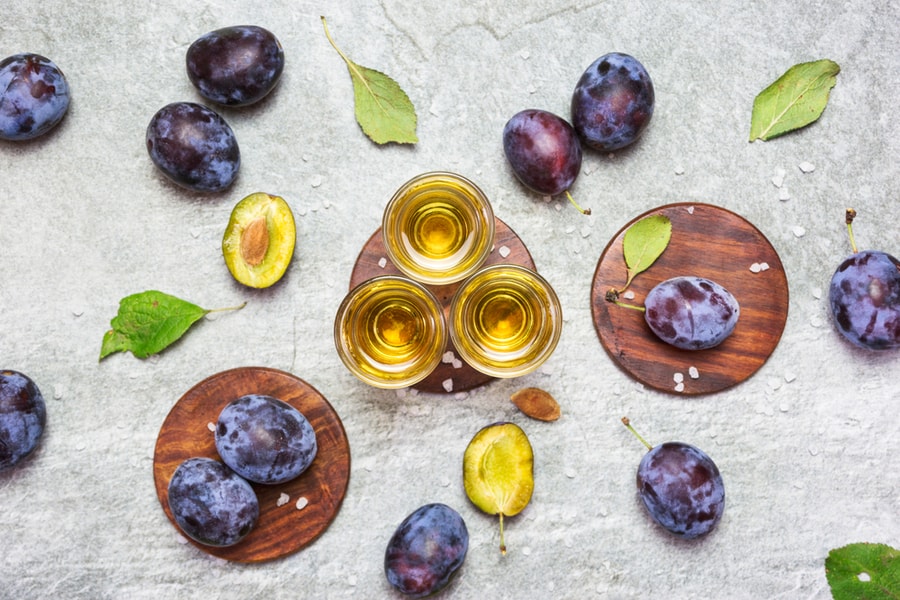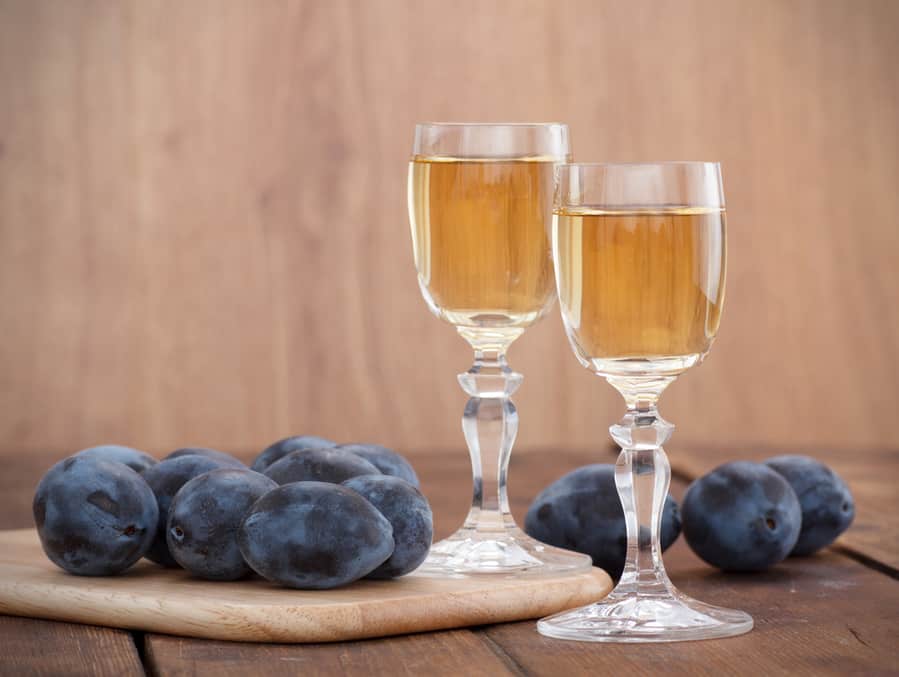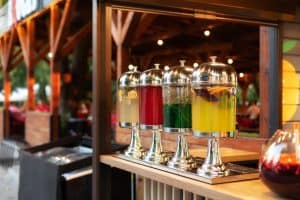
Slivovitz emerged as a way of putting excess plum harvests to good use. The resulting liquor perfectly captures the plum flavors and aromas. Slivovitz is produced in Eastern Europe and the Balkan Peninsula.
Slivovitz can be described as a “stubborn spirit.” It has a strong plum taste and a high alcohol proof which can sometimes overwhelm other ingredients when you mix up a cocktail.
Luckily, bartenders are innovative people who know how to tame stubborn spirits—we’ve listed two exceptional cocktails for you to try and linked some of the more ‘traditional’ slivovitz cocktails for you.
You could follow the Eastern European tradition of drinking slivovitz neat—sipping is recommended, or knocking it back as a shot might also work for you. But be warned, it has a robust alcoholic burn and might even knock your breath away!
We’ll examine what slivovitz is before we delve into the taste profile of slivovitz. In addition, we’ve listed some slivovitz brands for you to keep an eye out for at the liquor store or order online. Finally, we get to two unique cocktails, the Nicotine and the Slivopolitan, which you can add to your cocktail repertoire.
Okay, So What Is Slivovitz?

European nations each have their signature drinks—the French have absinthe, the Italians Amari, Greece has ouzo, and the Scandinavians have aquavit. In Eastern Europe and the Balkan Peninsula, they have slivovitz or plum brandy.
Simply put, slivovitz is a clear brandy made from damson plums in the eau de vie style. The taste is sometimes compared to the Italian grape-based brandy known as grappa.
Slivovitz was probably invented as a home-spun way to deal with excess plums during the fruit season. As the moniker goes, “necessity is the mother of invention.”
The purists will agree that the basic homemade version is the best version. It is illegal in the USA to distill spirits at home, so it might be best to get your slivovitz from a specialty liquor store.
How Is Slivovitz Made?
The home-spun version is made in small batches: ripe plums are mashed and left to ferment for around three weeks; the juice is then distilled and watered down to about 40% to 50% ABV and finally bottled or aged in oak barrels.
Another recipe does not require distillation but only boiling. Take as many ripe plums as you can find, mash them up, and place them in clean plastic buckets to ferment. If you are in a rush, add some sugar to jumpstart the fermentation process.
You’ll wait around three weeks and end up with a jam-like product. Whisk it all together and put it in a large pot (or cauldron if you have one) with 3–4 liters of water. Bring it all to a boil.
When it starts boiling, reduce the heat to a low simmer. You should end up with something that’s called a “soft rajika.” Remove the liquid from the pot (or cauldron), wash your pot, and put the soft rajika in it again with an equal amount of clean water.
The resulting liquid should preferably be stored in oak barrels to age and temper the alcohol taste. The longer it rests, the better the final product will taste.
What Does Slivovitz Taste Like?
Commercial slivovitz is bottled chiefly between 38% and 50% ABV (76–100 proof), so it will have an intense burning sensation in the mouth and throat. Oak aging certainly helps to tame the fiery alcohol content.
On the other hand, the aroma is distinctly plum with a hint of sweetness which is tempered with tastes of oak and almond. Slivovitz has a slightly dry taste and barely noticeable floral aftertaste.
How To Drink Slivovitz

Bartender Dashan Zaric refers to slivovitz as a “stubborn spirit” because it can easily overwhelm all the other ingredients in a cocktail or take a backseat and not come to the fore.
Let’s examine some brands before we delve into ways you can drink slivovitz.
Choosing a Slivovitz Brand
There are many brands to choose from. Still, a few stand out as palatable versions that won’t knock your breath out and won’t overpower any cocktail you decide to mix up. You can even cook with them or use them to flambé a Christmas pudding.
- Maraska: from Croatia, has an aroma of candied plums with a hint of toasted almonds. The taste is close to eau de vie without hitting you with jam and stone fruit flavors. The ABV is 40% (80 proof), so don’t fear having your breath knocked away.
- Navip 8 Year Old: hails from Serbia and is heavier in body and flavor than Maraska but also sweeter. It is also much more potent, clocking in at 50% ABV (100 proof). Because of its sweeter profile, it is a fantastic choice for cooking. It can be used to flambé a Christmas pudding, or if you are in a rush, use it to flambé some caramelized fruit for a quick and delicious dessert compote.
- Rudolf Jenik 10 Year Old: is imported from the Chech Republic and is an excellent choice for sipping and cocktails. The taste is oak-mellowed and might be described as a cross between brandy and bourbon.
- Strykover Premium Slivovitz: native to Poland, packs the most potent punch—77% ABV or 144 proof is not for the fainthearted! It has an intense fruity flavor, and a deep breath after each sip is undoubtedly recommended.
Drinking Slivovitz
Traditionally, slivovitz is enjoyed neat at room temperature. But let us explore some unique cocktails below to showcase how slivovitz can be enjoyed without knocking your breath away.
Apart from the traditional cocktails such as the Czech Sidecar, Monastery, Slivovitz Sour, Susina Sour, and Tesla Collins—all made with slivovitz—we’ll list two new and unique cocktails below if you don’t fancy knocking back slivovitz neat.
Nicotine
There’s no nicotine involved here, but it is a smoked cocktail. This cocktail was created by Tony Gonzales from District, Los Angeles, California, and features cacao nibs to bring smoothness and balance to the cocktail.
It combines sweetness, smokiness, and heat all in one glass. Unfortunately, this cocktail takes a bit of planning because you’ll need to infuse a bottle of Nonino amaro with cacao nibs for 10 days.
Follow this link for the full recipe.
Slivopolitan
Dushan Zaric, the co-founder of Employees Only in New York and a bartender, created the Slivopolitan to tame the strong taste of slivovitz and offer a balanced and enjoyable cocktail.
The Slivopolitan merges plum puree, slivovitz, fresh lime juice, Cointreau, and slivovitz into a single enjoyable drink.
You can follow Dushan’s recipe and whip up a few Slivopolitans for your next cocktail hour—you’ll be the host with one of the most exciting cocktails by far.
Conclusion
Slivovitz is a stubborn spirit that can easily overwhelm other ingredients in a cocktail. Still, slivovitz is a spirit you should seriously consider if you feel like conjuring up some unique cocktails. You can follow the European tradition of sipping it neat as well.
To take a slightly more philosophical turn, spirits hold the stories of the people who created them and provide a visceral means for indigenous peoples and interested outsiders to experience their past.
Gin reflects the West’s obsession with the unique tastes of its colonies. The grits and apple pie it enhances are as American as the bourbon.
And what about Slivovitz? It symbolizes a mentality that Eastern European Jews are all too familiar with: we’re all in this together, for better or worse. So, for the sake of cultural heritage, drink up.









